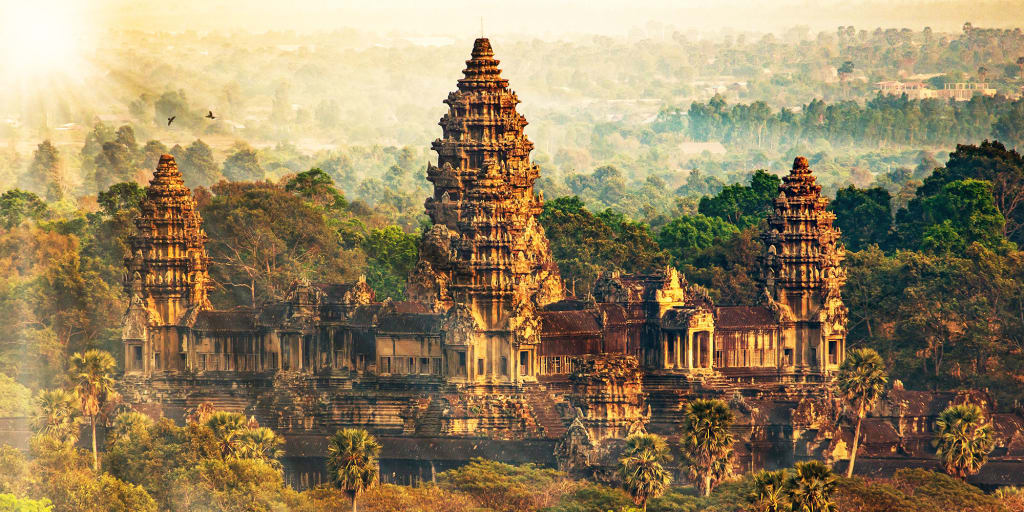
Angkor Wat is a magnificent structure that is one of the most important cultural and historical sites in Southeast Asia. This structure has become a major tourist attraction for those who are interested in culture, history, and architecture. Angkor Wat has become known as one of the most impressive and grandiose buildings that have stood the test of time.
Located deep in the heart of Cambodia, Angkor Wat is a symbol of the ancient Khmer civilization that once ruled over the region. This incredible structure is dated to the early 12th century and was built by the Khmer king Suryavarman II as a dedication to the Hindu god Vishnu. The incredible structure is actually a temple complex that consists of a series of interconnected buildings and towers. It is the largest religious monument in the world and is renowned for its incredible art and architecture, its historical and cultural significance, and its beauty.
The temple complex stands in Angkor, which was the capital city of the Khmer Empire that ruled between the 9th and 15th centuries. The complex consists of several rectangular walls and moats that encircle a central dome-shaped temple, standing at the heart of the complex. The site of Angkor spans over 400 square kilometers in total, with Angkor Wat located at the heart. The site is surrounded by a moat that is roughly 190 meters wide and covers a distance of 5.5 kilometers, while the temple itself is elevated over all of that at a height of over 60 meters.
The architectural beauty of Angkor Wat lies in its layout, design, and intricate decoration that speak of a deep inspiration and intention. The building design is a striking example of Khmer architecture that was native to the region, using mostly sandstone as the primary building material. The layout is constructed from layers of platforms that are elevated at different levels to symbolize the different levels of the world or heaven, earth, and the netherworld.
The complex of Angkor Wat consists of a series of courtyards, galleries, walls, towers, and temples, each contributing to the overall grandeur of the site. It has three different levels, each containing galleries and courtyards. The first level is situated on the base of the pyramid, which surrounds the central sanctuary and is called the outer gallery. The second level is known as the middle gallery and is also encircling the sanctuary, inside the outer gallery. The man-made pond serves two purposes- keeping the demons away and reflecting the beauty of the temple.
Finally, the third and highest level is the inner gallery, which is on top of the pyramid that houses the central sanctuary. The central sanctuary houses the most vital element of the structure: the statue of the powerful god Vishnu, who serves as the main centerpiece of the temple. This special room is accessed via a series of steep stairs, with the entry being heavily decorated with bas-relief carvings in honor of the god.
The meticulous detail and artistry of Angkor Wat's architecture are awe-inspiring and draw in thousands of tourists each year. One of the most impressive features of the temple complex is its intricate carvings, which cover over 2,000 square meters of wall space and are estimated to be up to 1,750 years old. These carvings are a testament to the skill of the Khmer artisans, who have captured the history of the region and the significance of religion and mythology in the culture's beliefs. The carvings are a true testament to the artistic and cultural achievements of the Khmer civilization.
The complex of Angkor Wat is also home to a large number of temples and religious monuments, each contributing to the overall magnificence of the area. Some of these temples have their very own breathtaking feature, but some are well-known for their uniqueness in the area.
These temples comprise the central Angkor Thom complex and some tiny temples outside of the Angkor Thom walls that together form a network of temples and religious monuments that stand as a testament to the grand longevity and cultural influence of the Khmer empire.
In addition, the complex of Angkor Wat also includes a series of large ponds and canals, which served as a vital source of irrigation, as well as a living space for aquatic life. The complex has lived up to its significance as a symbol of architecture and culture and has undergone restoration projects over the years to help preserve its grandeur and architectural styles. The efforts of its caretakers have been rewarded by being designated as a UNESCO World Heritage Site.
In conclusion, Angkor Wat is more than just a temple complex and historic monument. It is an important link to the rich history and culture of Southeast Asia, showing the complexity and scale of the Khmer civilization. Angkor Wat is a structure that is admired for its aesthetic appeal and acknowledged for its lasting cultural significance. Its blend of outstanding architecture, artistry, and historic influence is awe-inspiring and plays an essential role in Cambodia's cultural and historical heritage. For many, a visit to this magnificent temple complex is a once-in-a-lifetime experience that leaves a remarkable impression for years to come.
About the Creator
Enjoyed the story? Support the Creator.
Subscribe for free to receive all their stories in your feed. You could also pledge your support or give them a one-off tip, letting them know you appreciate their work.





Comments
There are no comments for this story
Be the first to respond and start the conversation.